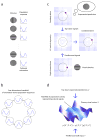Spontaneous and driven cortical activity: implications for computation
- PMID: 19647992
- PMCID: PMC3319344
- DOI: 10.1016/j.conb.2009.07.005
Spontaneous and driven cortical activity: implications for computation
Abstract
The traditional view of spontaneous neural activity as 'noise' has been challenged by recent findings suggesting that: (a) spontaneous activity in cortical populations is highly structured in both space and time, (b) the spatio-temporal structure of spontaneous activity is linked to the underlying connectivity of the cortical network, (c) spontaneous cortical activity interacts with external stimulation to generate responses to the individual presentations of a stimulus, (d) network connectivity is shaped in part by the statistics of natural signals and (e) ongoing cortical activity represents a continuous top-down prediction/expectation signal that interacts with incoming input to generate an updated representation of the world. These results can be integrated to provide a new framework for the study of cortical computation.
Figures

References
-
- Schultz G, Melzack R. The Charles Bonnet syndrome: ‘phantom visual images’. Perception. 1991;20:809–825. - PubMed
-
- Feynman RP. Surely you’re joking, Mr Feynman! W. W. Norton & Company, Inc; New York, N. Y: 1985.
-
- Tolhurst DJ, Movshon JA, Dean AF. The Statistical Reliability of Signals in Single Neurons in Cat and Monkey Visual-Cortex. Vision Research. 1983;23:775–785. - PubMed
-
- Shoham D, Glaser DE, Arieli A, Kenet T, Wijnbergen C, Toledo Y, Hildesheim R, Grinvald A. Imaging cortical dynamics at high spatial and temporal resolution with novel blue voltage-sensitive dyes. Neuron. 1999;24:791–802. - PubMed
Publication types
MeSH terms
Grants and funding
LinkOut - more resources
Full Text Sources

